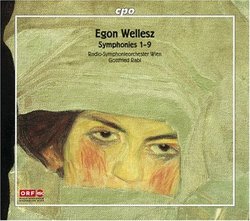| All Artists: Wellesz, Rabl, Radio-Symphonieorchester Wien Title: Egon Wellesz: Symphonies 1-9 (Complete) Members Wishing: 0 Total Copies: 0 Label: Cpo Records Original Release Date: 1/1/2009 Re-Release Date: 2/10/2009 Genre: Classical Style: Symphonies Number of Discs: 4 SwapaCD Credits: 4 UPC: 761203718320 |
Search - Wellesz, Rabl, Radio-Symphonieorchester Wien :: Egon Wellesz: Symphonies 1-9 (Complete)
 | Wellesz, Rabl, Radio-Symphonieorchester Wien Egon Wellesz: Symphonies 1-9 (Complete) Genre: Classical |
Larger Image |
CD Details |
CD ReviewsWorthwhile Composer Christopher A. Fulkerson | San Francisco | 04/27/2010 (4 out of 5 stars) "If you are interested in an incremental progression from Mahler to modern music, Wellesz would probably come one step after Mahler, two steps before Berg. He writes as though he often understood the craftsman's issues better than his more famous peers, though he was admittedly of a somewhat lower rank of genius than they were. He was more of a textbook contrapuntist than any other Schoenberg student (like Anton Webern he was a musicologist who also took lessons with the Master); this is evident from the first movement of the First Symphony, where an angular melody is taken up quite well as a stretto subject, yet every note is quite audible, and the countersubjects support, rather than confuse, the texture. Perhaps his most praiseworthy skill is that of finding just the right contrast between one idea and another; sometimes the nature of new ideas is quite prescient; he can tell you something through the selection of ideas alone. If you like some early Hindemith you might like Wellesz's take on the element of Neo-Classicism that is within the Schoenberg dodecaphonic project; some of the same clarity in phrasing is there; the style is more economic but with a certain amount of the same rhythmic vigor. Wellesz also likes the surprise sudden-tonic ending that typifies Hindemith, and he seems never to have eschewed octave doublings, so there is never the textural edge of the basic 20th Century sound. There is always something of the Fin-de-siecle Vienna mood in this music, no matter how late it was written.
When Wellesz occasionally writes using the twelve-tone system he is not orthodox and it does not constitute a radical departure from his textural and orchestrational norm. He has less than his teacher's tendency to resort to repeated note patterns once he writes using the twelve-tone system; ironically, under some circumstances he is perhaps momentarily more inventive, though less inspired, than Schoenberg. For better or worse, he has greater periodic phrase clarity than others of the New Vienna circle; this is usually welcome, but occasionally there is an over-reliance on formulas; I got tired of the use of the snare drum to articulate mid-level structure. There is an expressive gesture across the symphonies that moves from warmth and vigor to a bleak reserve; the last few symphonies tend toward a structure with a slow finale. He writes well for the instruments, and some of his woodwind and solo counterpoint is truly fine. This survey of Wellesz's symphonies is superbly performed from scores lovingly recreated by Gottfried Rabl, who describes the generally incomplete if not deplorable state of the Wellesz scores. This is not evident from the excellent performances given by the Radio-Symphonieorchester Wien under Rabl's direction. This should be a welcome addition to any collection of early modern orchestral music, and something that every student of the New Vienna School should hear. I recommend it." |
